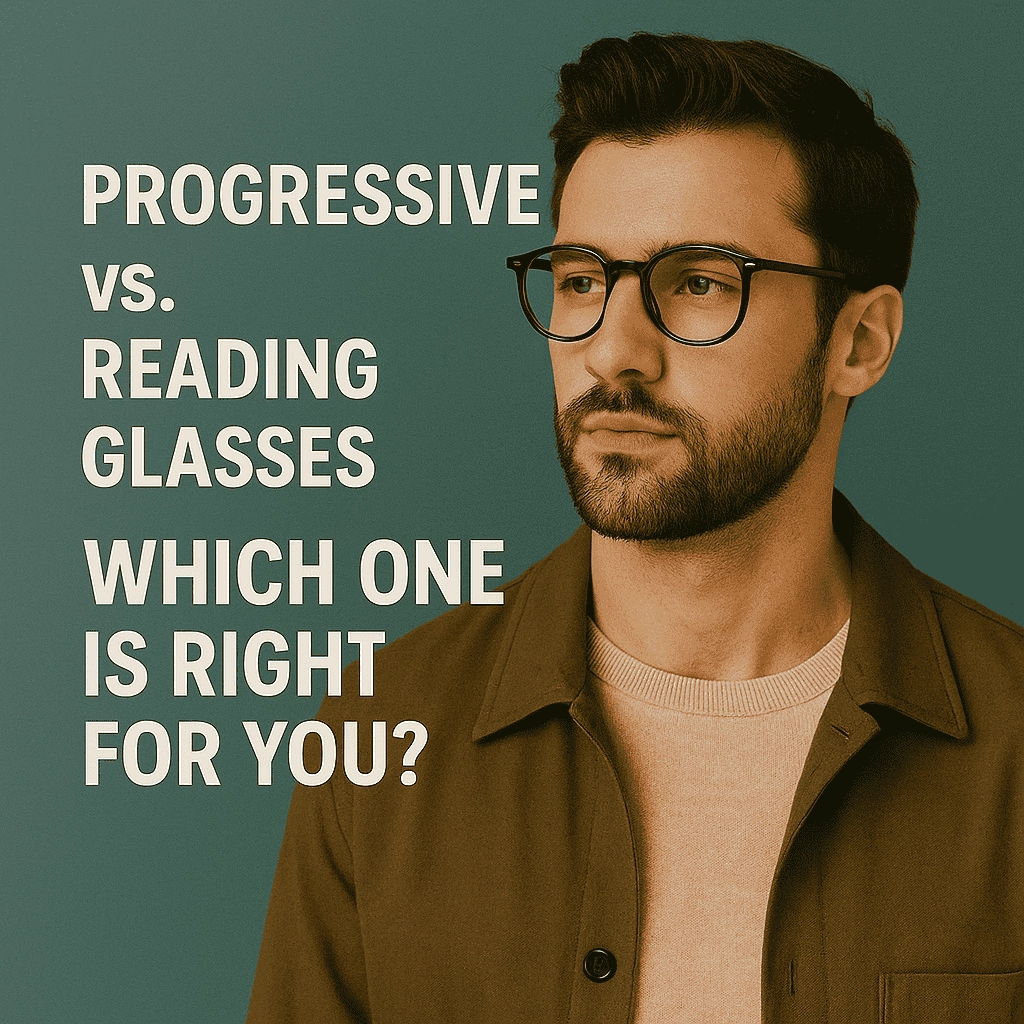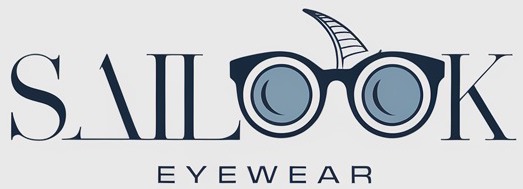When it comes to choosing the right eyewear, understanding the differences between progressive and reading glasses is essential for making an informed decision. Both types offer distinct advantages, but which one fits your lifestyle and vision needs? In this article, we’ll break down the key differences, the benefits and drawbacks of each option, and help you determine which type of glasses is right for you.

1. What Are Progressive Reading Glasses?
Progressive reading glasses are designed to offer clear vision at all distances, including close-up, intermediate, and far distances. Unlike traditional reading glasses, which are primarily used for close-up tasks like reading, progressive lenses provide a smooth transition between multiple vision zones. These lenses are ideal for people who need corrective lenses for both near and far vision but don’t want the bulky appearance of bifocals or trifocals.
But here’s the kicker: Progressive lenses are different because they do not have visible lines, making them a much more aesthetically pleasing option. Whether you’re reading a book, working on your computer, or driving, progressive lenses adjust seamlessly to your vision needs. They’re not only functional but also stylish.
Progressive lenses work by gradually changing the prescription from the top of the lens to the bottom. The top part is for distance vision, the middle part is for intermediate vision, and the bottom part is for near vision. This design allows the wearer to see clearly at all distances without switching glasses.
Progressive lenses are most beneficial for people experiencing presbyopia, a condition that occurs with age and affects the ability to focus on close objects. Presbyopia generally starts after the age of 40, and progressive lenses help correct this issue by providing a smooth transition in vision from one distance to another.
| Type of Vision | Function of Progressive Lenses |
|---|---|
| Distance | Top part of the lens for clear vision at a distance |
| Intermediate | Middle part of the lens for mid-range tasks like working on a computer |
| Near | Bottom part of the lens for close-up tasks like reading |
2. How Do Progressive Lenses Work?
Progressive lenses are an innovative solution to multifocal vision correction. These lenses are designed to provide a seamless transition between different vision zones, eliminating the need for multiple pairs of glasses. What’s the real story? They allow you to see clearly at all distances without the visible lines found in bifocal or trifocal lenses.
Unlike bifocals, which have a distinct line separating the distance and reading prescriptions, progressive lenses offer a gradual change in prescription from the top to the bottom of the lens. This means no visible lines and no awkward switching between different pairs of glasses. Instead, you get a smooth, natural transition that mimics the eye’s natural focus adjustments.
Here’s the good part: With progressive lenses, you won’t have to take off your glasses to switch between reading and seeing things at a distance. Whether you’re checking your phone or looking at something across the room, your progressive lenses adjust to your visual needs, providing clear vision in all situations.
Progressive lenses have three primary areas:
- Distance vision (top section) is ideal for activities like driving or watching television.
- Intermediate vision (middle section) is used for tasks like computer work or looking at objects that are at arm’s length.
- Near vision (bottom section) is perfect for close-up activities like reading or sewing.
| Vision Zone | Function |
|---|---|
| Distance | For far vision like driving and watching TV |
| Intermediate | For computer work or tasks at arm’s length |
| Near | For reading and close-up tasks |
3. What Are the Advantages of Progressive Reading Glasses?
Progressive reading glasses offer several advantages over traditional reading glasses or bifocals. The most significant benefit is the ability to see clearly at all distances, all within one pair of glasses. This eliminates the need to switch between different pairs of glasses, saving time and offering more convenience.
This is where it gets interesting: Progressive lenses allow for a more natural viewing experience. Unlike bifocals or trifocals, which can cause distortion at the edge of the lens, progressive lenses provide a smooth transition between vision zones. You can go from reading to seeing far distances without any disruption in clarity.
Another advantage is aesthetics. Progressive lenses do not have the visible lines that bifocals and trifocals do. This makes them a more attractive option for those who are concerned about the appearance of their eyewear. They also offer more comfort, as there’s no need to switch glasses or tilt your head at awkward angles to find the right focal point.
Progressive lenses are ideal for those with presbyopia who still want to maintain an active lifestyle without worrying about constantly changing glasses. They are also more convenient for people who work on the computer or engage in activities that require varied focal distances.
| Advantages | Benefits |
|---|---|
| Convenience | No need for multiple pairs of glasses |
| Aesthetics | No visible lines, more attractive than bifocals |
| Comfort | Seamless transition between vision zones |
4. Are Progressive Reading Glasses Better Than Regular Reading Glasses?
If you’re wondering whether progressive reading glasses are better than regular reading glasses, the answer largely depends on your vision needs. Regular reading glasses are specifically designed for close-up tasks like reading, whereas progressive lenses offer versatility by covering all vision zones—near, intermediate, and far.
What’s the real story? If you only need glasses for reading and don’t mind switching between pairs of glasses for different tasks, regular reading glasses might be a simpler and more cost-effective solution. However, if you need a more flexible solution that allows you to see clearly at various distances without constantly switching glasses, progressive lenses may be a better fit.
Progressive reading glasses provide more convenience and are particularly useful for people who have presbyopia or other vision conditions that require multiple focal points. Regular reading glasses, on the other hand, are a more straightforward option for those who don’t need the added complexity of multiple vision zones.
| Feature | Progressive Reading Glasses | Regular Reading Glasses |
|---|---|---|
| Use Case | Near, intermediate, and far vision | Close-up tasks like reading |
| Cost | Generally more expensive | Usually more affordable |
| Comfort | Seamless transition between zones | Only for reading, no versatility |
5. How to Choose Between Reading Glasses and Progressive Lenses?
Choosing between reading glasses and progressive lenses depends on several factors, including your lifestyle, vision needs, and budget. If you primarily need glasses for reading and don’t require correction for distance vision, regular reading glasses are a great choice. They’re affordable, easy to use, and effective for close-up tasks.
But here’s the kicker: If you find yourself needing to switch between reading glasses and distance glasses for activities like driving or working on the computer, progressive lenses might be the better option. They provide a seamless experience for various distances and eliminate the hassle of changing glasses throughout the day.
Before making a decision, consider how often you need to see at different distances, whether you’re willing to pay a premium for the added convenience, and how much time you spend on tasks that require both near and far vision.
| Consideration | Reading Glasses | Progressive Lenses |
|---|---|---|
| Cost | Affordable | Higher cost |
| Convenience | Less convenient (need multiple pairs) | More convenient (one pair for all distances) |
| Lifestyle | Best for reading or close-up tasks | Best for people who need clear vision at all distances |
6. How Do Progressive Reading Glasses Help With Presbyopia?
Presbyopia is an age-related condition that affects your ability to focus on close-up objects. It typically begins around the age of 40 and worsens over time. Progressive reading glasses are an excellent solution for presbyopia because they provide a smooth transition between near, intermediate, and far vision, allowing you to see clearly at all distances without needing to switch glasses.
What’s the real story? Without progressive lenses, individuals with presbyopia often need separate glasses for reading and distance vision. This can be cumbersome and inconvenient. Progressive lenses provide a more practical and comfortable solution, helping people manage presbyopia while maintaining an active lifestyle.
The smooth transition in progressive lenses mimics the natural focusing process of the eyes, which makes them a more comfortable option than traditional reading glasses or bifocals. You can wear them all day long without having to swap glasses for different tasks, which makes them a popular choice for people with presbyopia.
| Benefit for Presbyopia | Progressive Lenses |
|---|---|
| Seamless Vision | Smooth transition between near, intermediate, and far vision |
| Convenience | One pair of glasses for all distances |
| Comfort | Mimics the natural focusing process of the eye |
7. Are Progressive Lenses Suitable for All Ages?
Progressive lenses are generally recommended for individuals over 40, as this is when presbyopia typically starts to affect vision. However, younger individuals with specific vision needs, such as astigmatism or nearsightedness, can also benefit from progressive lenses.
But here’s the kicker: If you’re under 40 and experience difficulty focusing at different distances, it might be worth discussing progressive lenses with your eye care professional. Some people may require progressive lenses due to specific vision conditions, even at a younger age.
While most progressive lens users are in their 40s or older, there’s no age limit to wearing them. The key is to determine whether progressive lenses will address your vision needs and whether you’re ready to adapt to the transition between vision zones.
| Age Group | Benefits of Progressive Lenses |
|---|---|
| Under 40 | Can help with vision conditions like astigmatism or nearsightedness |
| 40 and over | Ideal for managing presbyopia and providing seamless vision |
8. What Are the Disadvantages of Progressive Reading Glasses?
While progressive reading glasses offer numerous benefits, they also come with a few disadvantages. One of the main challenges is the adjustment period. It can take time to get used to the different focal zones, especially if you’re switching from regular reading glasses or bifocals.
Ready for the good part? The adjustment period usually lasts a few days to a few weeks, but it can be frustrating for some people. You may experience distortion or difficulty seeing clearly at first, but this typically improves as your eyes adjust to the new lenses.
Another drawback is the cost. Progressive lenses are generally more expensive than regular reading glasses, which can be a deterrent for some people. However, the added convenience and functionality may justify the higher price for many users.
| Disadvantage | Explanation |
|---|---|
| Adjustment period | Can take time to get used to the different focal zones |
| Cost | More expensive than regular reading glasses |
9. How to Choose the Right Frame for Progressive Lenses?
Choosing the right frame for progressive lenses is crucial for both comfort and functionality. The frame should be large enough to accommodate the multiple vision zones, ensuring a smooth transition between the near, intermediate, and far sections of the lens.
What’s the real story? Frames that are too small or narrow may not provide enough space for the different vision zones, making it difficult to adjust to progressive lenses. It’s also important to select a frame that fits comfortably on your face to avoid discomfort during long wear.
| Frame Feature | Consideration for Progressive Lenses |
|---|---|
| Size | Large enough to accommodate all vision zones |
| Fit | Comfortable and well-fitted to prevent discomfort |
| Style | Choose a style that suits your personal preference |
10. Can You Use Progressive Lenses for Computer Work?
Progressive lenses are a great choice for computer work because they allow for clear vision at both near and intermediate distances. But here’s the kicker: The intermediate zone of progressive lenses is perfect for tasks like working on a computer or reading documents at arm’s length.
Unlike regular reading glasses, which are designed only for close-up tasks, progressive lenses give you a more versatile solution for people who spend a lot of time working on the computer. You won’t need to constantly switch between glasses for different tasks, making them more convenient for digital work.
| Task | Vision Zone Needed |
|---|---|
| Reading a book | Near vision |
| Using a computer | Intermediate vision |
| Driving | Distance vision |
11. How Long Does It Take to Adjust to Progressive Lenses?
It typically takes a few days to a few weeks to adjust to progressive lenses. Some users may experience dizziness, blurred vision, or discomfort at first, but this usually improves as your eyes adapt. What’s the real story? Wearing your glasses consistently during this period is key to making the transition as smooth as possible.
| Adjustment Stage | Tips for a Smooth Transition |
|---|---|
| First few days | Wear them for short periods and gradually increase wear time |
| Ongoing | Follow up with your eye care professional for fitting adjustments |
12. Can Progressive Lenses Be Prescribed for Reading Glasses Only?
Yes, progressive lenses can be customized for reading-specific use. While traditional progressive lenses offer clear vision at all distances, you can opt for lenses that focus primarily on near vision, with some intermediate functionality for tasks like using a computer. This option is ideal for people who mainly need glasses for reading and close-up work.
| Lens Type | Function |
|---|---|
| Traditional Progressive | Near, intermediate, and far vision |
| Reading-Specific Progressive | Focus on near vision with some intermediate |
13. How Do Progressive Lenses Affect Your Appearance?
Progressive lenses offer a sleek and modern look compared to bifocals or trifocals, which can be bulky and have visible lines. Ready for the good part? Progressive lenses are discreet and allow you to maintain a stylish appearance while benefiting from multifocal vision correction.
| Aesthetic Benefit | Description |
|---|---|
| No visible lines | Looks more like single-vision lenses |
| Sleek design | Keeps you looking stylish and modern |
14. How to Care for Your Progressive Reading Glasses?
To maintain the quality of your progressive reading glasses, regular cleaning and proper storage are essential. What’s the real story? Use a microfiber cloth to clean the lenses and avoid using harsh chemicals that could damage the coating. Store your glasses in a case to prevent scratches when not in use.
| Care Tip | Explanation |
|---|---|
| Cleaning | Use a microfiber cloth to avoid scratches |
| Storage | Keep in a protective case to prevent damage |
15. What Are the Common Misconceptions About Progressive Lenses?
One common misconception is that progressive lenses are difficult to adapt to or uncomfortable. But here’s the kicker: Most people adjust quickly, and the comfort level improves with consistent use. Another misconception is that progressive lenses are only for older adults, but younger individuals with vision issues like astigmatism can benefit from them as well.
| Misconception | Reality |
|---|---|
| Hard to adjust | Most people adjust within a week or two |
| Only for older adults | Progressive lenses can benefit younger users too |
Conclusion
Choosing between progressive and regular reading glasses ultimately depends on your lifestyle and vision needs. While reading glasses are perfect for close-up tasks, progressive lenses provide a seamless solution for those who need clear vision at various distances, making them more versatile. Although progressive lenses come with a higher price tag, the added convenience and aesthetic benefits make them a worthwhile investment for many. Whether you’re managing presbyopia or simply looking for a more convenient eyewear solution, understanding the differences between these two options is crucial for making the right choice.
FAQ Section
- Q1: What are progressive reading glasses?
Progressive reading glasses are multifocal lenses that provide clear vision at near, intermediate, and far distances without visible lines, offering a seamless experience. - Q2: How do progressive lenses work?
Progressive lenses gradually change in prescription from the top for distance vision to the bottom for near vision, offering a smooth transition between different vision zones. - Q3: Are progressive lenses suitable for younger people?
Yes, while they’re commonly used by those over 40, younger individuals with specific vision conditions may also benefit from progressive lenses. - Q4: How do I adjust to progressive reading glasses?
It may take a few days to a few weeks to adjust. Start wearing them for short periods and gradually increase usage. Consult your optician if adjustments are needed. - Q5: What’s the difference between progressive and reading glasses?
Reading glasses are for near vision only, while progressive lenses offer a seamless transition between near, intermediate, and far vision without visible lines.

